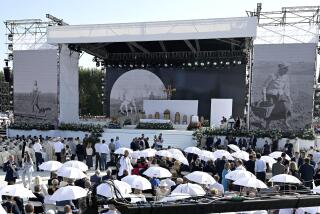On This Day, the Pope Is Karol Wojtyla Again : Religion: Visiting his birthplace for the first time since 1979, John Paul sees old friends and familiar sites.
- Share via
WADOWICE, Poland — Tradition endures in the main square of this solid and stolid village in southern Poland: the yarn shop, the hardware store and its stock of hand-cranked meat grinders, the storefront beauty parlor promising hair styles and colors not lately seen in big cities farther west.
Sure, there is change, too, on the perimeter of a square planted in young pines and red roses: a modern bookstore, a high-tech shop selling compact discs and one offering cheap religious souvenirs. There is even a karate academy.
Yet Wadowice’s earthy essence has changed as little as the hometown boy who came home Wednesday to the banks of the Skawa River to tap from his roots. He came on a sentimental journey in a black Mercedes-Benz with a long retinue and left in a white van with bulletproof glass sides.
Pope John Paul II is the best thing that ever happened to Wadowice. But to his former neighbors, he is still Karol Wojtyla, the bright, earnest young man who went off to become a priest.
“I remember when his father used to walk him through the street by the hand. He was a happy, normal little boy,” said Tadeuz Datka, an 85-year-old lawyer who was among the two dozen friends and former neighbors John Paul greeted in Wadowice’s eclectic St. Mary’s Church.
Karol Wojtyla was born in 1920 not far from St. Mary’s at 7 Koscielma (Church) St. He was baptized there, and his neighbors recalled Wednesday how he would sometimes stop to pray on his way home from school.
“Even when we were young, he was exceptional. He heard something once, and he remembered it all,” said Rafat Tatka, a 75-year-old Wojtyla contemporary. “Now he is a great man who wants to unify the Christian movement in the whole world. And he is a great Pope, although I disagree with his positions against abortion and women priests. I am more liberal than he is.”
The Pope lingered affectionately in Wadowice on Wednesday en route to an annual prayer jamboree at the nearby shrine city of Czestochowa, which is attracting up to 1 million Roman Catholic young people from around the world. His visit there will climax with a gigantic open-air Mass this morning.
Framed by fields of neatly stacked hay, Wadowice was the picture of well-scrubbed tranquility Wednesday, but at a lunch with former high school and seminary classmates, John Paul reminded them that Holocaust once ruled the Polish countryside. Wadowice is about an hour’s drive from the World War II extermination camp at Auschwitz, now a museum and monument after wreaking a horror that stunned young people who paused there on their way to their appointment with the Pope. He prayed there early in his reign.
“In school at Wadowice there were Jewish believers who are no longer among us. There is no longer a synagogue near the school,” John Paul reminded his contemporaries in improvised remarks at the lunch. When a plaque was unveiled at the site where the synagogue once stood, he said, he sent a letter “to one of our (Jewish) friends” expressing solidarity.
“In a certain sense it is true your people were on the front line, its suffering, its destruction,” the Pope said he wrote. “Whenever they (Jews) talk to nations, to people, to humanity, they speak with a voice of warning,” he told his luncheon guests, saying he had written: “In your name, this voice of warning is raised by the Pope. The Polish Pope has a special relationship to that because together with you, somehow we lived through all that here in our fatherland.”
Bells pealed and the town band tooted a mighty welcome as John Paul returned to his birthplace for the first time since 1979, a year after being elected Pope. “Welcome Home,” read a banner before the church with a fresh-painted gray and white face, a bulbous black dome and a steeple clock.
Inside an 11-altar church built in bits and pieces between the 15th and 19th centuries, John Paul prayed at the main altar and baptismal font. Then, trailed by a rosary-dispensing secretary, he blessed and exchanged pleasantries with his neighbors.
Later, at the dedication of a new church in the modern part of the town of 15,000--whose economy depends on the surrounding countryside and small metallurgical, paper and ceramic factories--John Paul offered more formal tribute to his roots, preaching from the Gospel of St. Matthew: “You are Christ, son of the living God.”
“I greet you, my homeland. I greet you, my native city on the Skawa River. Here in this city, in this old parish church, I have heard this confession of faith for the first time,” the Pope said. “Today, after so many years, how grateful I am to you, my mother, my father, my brother. . . . How grateful I am to you, ancient Wadowice.”
Karol Wojtyla left Wadowice in 1938 after graduating from high school. War caught him in Krakow, about an hour’s bus ride away. He began clandestine seminary studies there and was ordained in 1946. He was a cardinal and archbishop of Krakow when the College of Cardinals elected him the first non-Italian Pope in more than 400 years.
Coming home again, John Paul made only one concession to eminence. He was to have visited the three-room, second-story apartment where he was born, which has been converted into a simple museum. But he was running late. So he blessed it instead from his Popemobile as it drove slowly down Church Street.
More to Read
Sign up for Essential California
The most important California stories and recommendations in your inbox every morning.
You may occasionally receive promotional content from the Los Angeles Times.










